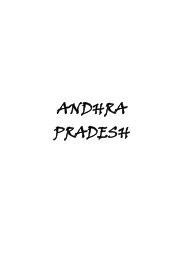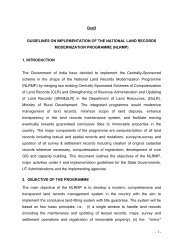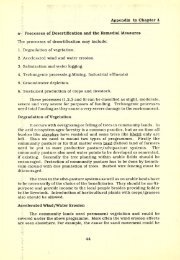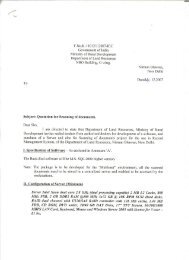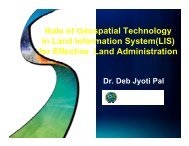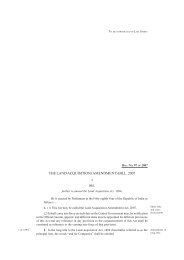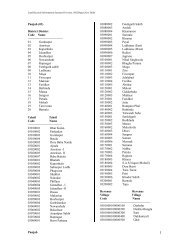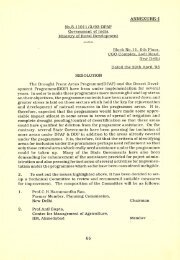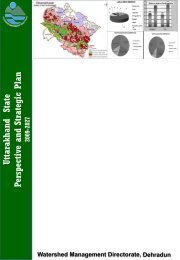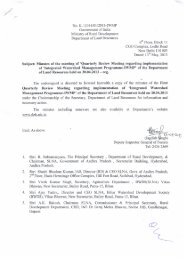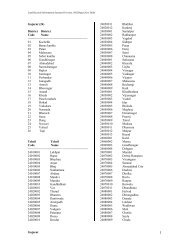Download
Download
Download
Create successful ePaper yourself
Turn your PDF publications into a flip-book with our unique Google optimized e-Paper software.
REDEFINING THE HORIZONTAL & VERTICAL<br />
CONTROL IN INDIA, GCPs, DATUM<br />
TRANSFORMATION, UPDATION OF LAND RECORDS<br />
: CONTRIBUTIONS OF SURVEY OF INDIA<br />
U. N. Mishra<br />
Director<br />
Geodetic & Research Branch
Activities of Geodetic & Research Branch<br />
Responsible<br />
to<br />
Provide<br />
Horizontal<br />
and<br />
Vertical<br />
Control<br />
Determination<br />
of<br />
Transformation<br />
Parameters –<br />
between WGS-84<br />
and Everest. These are available<br />
with G&RB<br />
GCP Library Project – About to complete<br />
Antarctica Expedition – Participation since 1990-91<br />
91<br />
National GPS Data Centre –Analysis<br />
of GPS data<br />
received from Permanent Stations in India<br />
Real Time GPS Data Centre – Receiving GPS data<br />
from Tidal Ports in India<br />
Redefinition of Indian Vertical Datum
Activities of Geodetic & Research Branch<br />
Contd.<br />
Geodetic & Geophysical<br />
studies-Gravity,<br />
Geomagnetism<br />
Astronomical<br />
Observations-Determination<br />
of<br />
True North<br />
Collection, processing and archiving of Tidal<br />
Data along the Indian coast.<br />
Publication of Indian Tide table and Hugli river<br />
tide tables every year in advance.<br />
Redefinition of Indian Vertical Datum<br />
Data dissemination<br />
Capacity building/Training
Requirement of Datum and Coordinate System<br />
To perform surveying and Mapping a datum<br />
and coordinate system is required.<br />
4
What is Datum?<br />
A<br />
datum<br />
(plural<br />
datums)<br />
is a reference<br />
from<br />
which<br />
measurements are made.<br />
It is an associated model of the shape of the earth (ellipsoid) to<br />
define a Geographic Coordinates.<br />
Horizontal datums are used for describing a point on the<br />
earth’s surface, in latitude and longitude or another coordinate<br />
system.<br />
Vertical datums measure elevations or depths.<br />
5
Datum used in Surveying:<br />
Horizontal Datum- (Ellipsoid)<br />
Vertical datums – (Geoid/MSL)<br />
6
Geoid<br />
Figure of Earth<br />
Geoid (Close to<br />
MSL)<br />
2/15/2012 7
Actual shape of earth<br />
2/15/2012 8
The Ellipsoid<br />
The Geoid is a complicated surface defined by infinite<br />
number of observed gravity points, hence not suitable to<br />
perform mathematical computations.<br />
The ellipsoidal surface is smooth and convenient for<br />
mathematical operations.<br />
Therefore ellipsoid is widely used as the reference surface<br />
(datum) for horizontal coordinates in geodetic network.<br />
2/15/2012 9
Ellipsoid (Best Fit Mathematical Surface)<br />
Figure of Earth<br />
Ellipsoid (GRS80)<br />
2/15/2012 10
Horizontal Datum:<br />
An Ellipsoid is Used as Horizontal Datum.<br />
Its centre coincides with the centre mass of the<br />
earth.<br />
Its minor axis is parallel to the axis of rotation<br />
of the earth.<br />
Everest ellipsoid was used as a Horizontal<br />
datum in India and adjacent countries<br />
2/15/2012 11
Everest Ellipsoid<br />
Evolved from measurement of great Meridonial arc from<br />
Kanyakumari to Banog near Mussoorie.<br />
Arc closely passes through 78 0 E Meridian.<br />
Col. Lambton started the observation of Great Arc on 10 April<br />
1802 from St. Thomas Mount, Madras by measuring a base line<br />
of 40006.4 feet (12194m)<br />
m).<br />
Sir George Everest in 1830 concluded the task of Great Arc<br />
measurement by<br />
computing the parameters of the Ellipsoid<br />
which was named after him.<br />
The values are as under<br />
a = 6377301.243m<br />
b = 6356100.231<br />
231m<br />
f = 1/300.8017<br />
2/15/2012 12
2/15/2012 13
World Geodetic System 1984 (WGS-84)<br />
For all practical purposes, the GRS80<br />
and WGS84<br />
ellipsoids are identical.<br />
WGS84<br />
was designed to be a practical standard global,<br />
geocentric horizontal datum for:<br />
Mapping<br />
Charting<br />
Geodesy and<br />
Navigation<br />
2/15/2012 14
Bureau International de l’Heure (BIH)<br />
WGS84 Ellipsoid<br />
2/15/2012 15
Best Fit Ellipsoid and Geocentric Ellipsoid<br />
Figure of Earth<br />
Geoid (Close to MSL)<br />
Locally Best-fit Ellipsoid<br />
(Everest Ellipsoid)<br />
Centre of Mass of<br />
Earth<br />
Geocentric Ellipsoid<br />
(GRS80)<br />
2/15/2012 16
International Terrestrial Reference Frame (ITRF)<br />
In the Surveying terminology, a reference frame is a set<br />
of points with their coordinates which realize an ideal<br />
reference system<br />
The International Earth Rotation Service (IERS) mission<br />
is<br />
to<br />
provide<br />
internationally<br />
accepted<br />
terrestrial<br />
reference systems<br />
ITRF is produced by IERS<br />
The ITRF is realized through the global Cartesian coordinates<br />
and linear velocities of a global set of sites equipped with<br />
various space geodetic observing systems.<br />
The space geodetic techniques used at present are LLR, SLR,<br />
VLBI, GPS, and DORIS (Doppler Orbitography and Radio-<br />
positioning Integrated by Satellite, is a French precision<br />
navigation system)<br />
2/15/2012 17
IGS<br />
The International GNSS Service (IGS) is a voluntary federation of<br />
many worldwide agencies<br />
IGS collects, archives, and distributes GPS observation data sets of<br />
sufficient accuracy to satisfy the objectives of a wide range of<br />
applications and experimentation.<br />
IGS has a number of components:<br />
an international network of over 500 continuously operating dual-<br />
frequency GNSS stations<br />
More than a dozen regional and operational data centers<br />
three global data centers<br />
seven analysis centers and a number of associate or regional analysis<br />
centers<br />
2/15/2012 18
IGS Stations<br />
2/15/2012 19
Status of Horizontal Control in India - Past<br />
Old Geodetic Triangulation<br />
GT Triangulation was started on 10 th April, 1802 with an aim<br />
to<br />
design a Horizontal<br />
datum<br />
for<br />
India<br />
and<br />
adjacent<br />
countries<br />
Observation – Theodolite for angular and Invar wire for<br />
linear measurements<br />
Layout – Geometrical<br />
figure<br />
adjustment can be performed<br />
and<br />
network<br />
so<br />
that<br />
Result – Everest Ellipsoid as Indian Geodetic Datum,<br />
Horizontal<br />
coordinates<br />
for<br />
surveying<br />
and<br />
mapping<br />
activities<br />
In all 2873 GT stations in India situated on high hill tops.<br />
Present status – Switch over from Everest to WGS-84
Status of Horizontal Control in India - Past
Status of Horizontal Control in India - Past<br />
Number of Series of Indian Triangulation – 37<br />
Primary and 57 Secondary.<br />
One Series is adjusted within it but most of the<br />
series<br />
are<br />
not<br />
adjusted<br />
among<br />
themselves<br />
resulting in mismatch at junctions.<br />
Accuracy<br />
achieved<br />
is<br />
inferior<br />
compared<br />
accuracy achieved through GPS technology.<br />
to
Status of Horizontal Control in India - Present<br />
GCP Library Phase - I<br />
The Phase-I consists of about 300 points spacing about 250 to 300<br />
km apart<br />
These points will serve as the framework for geodetic control for<br />
entire country.<br />
These points has permanent monumentation.<br />
GPS observations have already been completed using Dual<br />
frequency GPS receivers on all these stations in static relative<br />
mode w.r.t. IGS<br />
Geodynamics Studies).<br />
Stations<br />
(International<br />
GPS<br />
Stations<br />
for
GCP Library Phase – I<br />
Monument<br />
Design of GCP Library Phase-I Monument
GCP Library Phase-I: Distribution in India<br />
1 Andhra Pradesh 21<br />
2 Assam & Nagaland 11<br />
3 Bihar 9<br />
4 Chhattisgarh 8<br />
5 Delhi 1<br />
6 Gujarat, Daman & Diu 22<br />
7 Haryana 6<br />
8 Himanchal Pradesh 7<br />
9 Jammu & Kashmir 10<br />
10 Jharkhand 8<br />
11 Karnataka 21<br />
12 Kerala & Lakshyadeep 6<br />
13 Madhya Pradesh 18<br />
14 Maharashtra & Goa 24<br />
15 Meghalaya & Arunachal Pradesh 6<br />
16 Orissa 11<br />
17 Punjab & Chandigarh 7<br />
18 Rajasthan 25<br />
19 Tamilnadu, Pondi, A&N Islands 16<br />
20 Tripura, Manipur & Mizoram 6<br />
21 Uttar Pradesh 22<br />
22 Uttarakhand 15<br />
23 West Bengal & Sikkim 11<br />
Total 291
Achievements: GCP Phase-I<br />
Phase-I:<br />
Observations on 291 stations in different states is<br />
completed<br />
Coordinates of all points has been computed using<br />
Bernes 5.0 software with reference to IGS stations in<br />
ITRF 2008 (Epoch 2005)
Subsequent Phases Of GCP Library<br />
Phase-II<br />
The control is being densified by providing 2200 points at the spacing of 25 to<br />
30 km<br />
This task is under progress and following states have already been covered<br />
Phase-III<br />
HP, Haryana, Punjab<br />
MP, UP, Bihar (North)<br />
Maharastra, Gujrat<br />
Karnataka, Kerala, Tamilnadu<br />
Andhra Pradesh, Orissa, WB<br />
Uttarakhand<br />
Rajasthan: GPS Observation is in Progress<br />
Control will be further densified by regional directorates of Survey of India at<br />
the spacing of 8 to 10 km (about 7000 points)
Subsequent Phases Of GCP Library<br />
Phase-II<br />
States where observations has to be done in next a few months<br />
Chattisgarh, South Bihar, Jharkhand (Naxalite<br />
Belt area)<br />
J & K State<br />
North Eastern States including Sikkim.
Achievements: GCP Phase-II<br />
Phase-II<br />
Observations has been completed in the following states<br />
Name Of State<br />
No. of Phase II GCP Observe<br />
Punjab, Haryana, Himachal (31+35+22) = 88<br />
MP, UP, Bihar (178+84+50) = 312<br />
Maharastra, Gujrat (219+145) = 364<br />
Karnataka, Kerala, Tamilnadu (132+45+106) = 283<br />
AP, Orissa, WB (244+95+67)= 406<br />
W UP and Uttarakhand 86<br />
Rajasthan (work in progress) 100<br />
Total GCP Observed 1639
Achievements: GCP Phase-II<br />
Field work will<br />
start in June / July<br />
Work in Progress 2012<br />
Field work will<br />
start in 3 rd week<br />
of Feb 2012
Network Adjustment Strategy<br />
Coordinates of CORS will be computed with reference to ITRF 2008 (Epoch2005) coordinates of<br />
IGS Stations. Here epoch referes to the co-ordinates<br />
ordinates of IGS station on 1 st January, 2005. We are<br />
adjusting the co-ordinatesordinates of 1 st<br />
phase points with reference to Permanent Continuous<br />
Operating Reference Stations (CORS). As we know that the Indian plate is moving like other<br />
plates of earth due to plate tectonic. It is also seen that Indian plate is having appreciable<br />
velocity of the order of 5-6 cm par annum.<br />
If we adjust our Ist Phase points with respect to our permanent CORS better adjustment will<br />
result under appreciable velocity of Indian plate.<br />
IGS<br />
(HYDE)<br />
CORS<br />
Phase-I<br />
Phase-I<br />
IGS<br />
(IISC)<br />
CORS<br />
Phase-I<br />
Phase-I
Contd…<br />
Owing to velocity factor due to movement of Indian<br />
plates the co-ordinates<br />
ordinates of a point will be different in<br />
different<br />
years<br />
but<br />
all<br />
the<br />
co-ordinatesordinates<br />
are<br />
standardised at epoch 2005 in ITRF 2008 reference<br />
frame.<br />
So, co-ordinates<br />
ordinates may be revised after 10 – 15 years to<br />
different ITRF epoch.<br />
User agency should adopt the co-ordinates<br />
ordinates supplied<br />
by SOI only for consistency.
GCP Phase-I Network: Adjusted with reference to CORS<br />
• At present the<br />
network is being<br />
adjusted using the<br />
vendor software.<br />
• However, after<br />
completion of entire<br />
work of Phase-II<br />
also, network is<br />
proposed to be<br />
adjusted using<br />
BIGADJUST<br />
programme as a<br />
measure of<br />
independent check.
GCP Phase-II Network: Adjusted with reference to<br />
Phase-I
Accuracy Expected<br />
Positional accuracy of control points after final adjustment is<br />
expected to be better than<br />
3cm<br />
for Phase-I GCPs<br />
9cm<br />
for phase-II<br />
GCPs and<br />
15 cm cm for phase-III<br />
GCPs
Accuracy Expected<br />
Positional accuracy of control points after final adjustment is<br />
expected to be better than<br />
3cm<br />
for Phase-I GCPs<br />
9cm<br />
for phase-II<br />
GCPs and<br />
15 cm cm for phase-III<br />
GCPs
National GPS Data Centre<br />
National<br />
GPS Data Centre<br />
was setup under Satellite<br />
Geodesy Wing in March 2001 for deformation and plate<br />
motion studies<br />
It has the mandate of receiving, analyzing and archiving of<br />
Permanent GPS stations data across the country<br />
The data is being received and archived from Permanent<br />
GPS stations<br />
This data is available for sharing with<br />
other scientific<br />
organizations for scientific studies.
PANAMIC<br />
JAMMU & KASHMIR<br />
LEH<br />
PUNJAB<br />
NADDI<br />
KOTHI<br />
HIMACHAL<br />
PRADESH<br />
DEHRADUN<br />
HARYANA<br />
HENLE<br />
UTTARAKHAND<br />
INDIAN GPS NETWORK<br />
BHATWAR<br />
I<br />
NATIONAL GPS DATA CENTRES,DEHRADUN<br />
MUNSIYARI<br />
ALMORAI<br />
PITHORAGARH<br />
DELHI<br />
GANGTOK<br />
RAJASTHAN<br />
LUCKNOW<br />
KANPUR<br />
UTTAR PRADESH<br />
BOMDILA<br />
SIKKIM<br />
TEJPUR<br />
GUAHATI<br />
SHILLONG<br />
MUKUKCHUNG<br />
BIHAR<br />
MEGHALAYA<br />
BANGLADESH<br />
IMPHAL<br />
KANDLA<br />
OKHA<br />
PORBANDAR<br />
VERAVAL<br />
VADINAR<br />
GUJARAT<br />
BHOPAL<br />
MADHYA PRADESH<br />
JABALPUR<br />
DHANBAD<br />
JHARKHAND<br />
WEST BENGAL<br />
GARDEN REACH<br />
DIAMOND HARBOUR<br />
HALDIA<br />
SAGAR<br />
ORISSA<br />
BHUBANESHWAR<br />
PARADIP<br />
MUMBAI<br />
JNPT<br />
JAIGARH<br />
ARABIAN<br />
SEA MARMAGAO<br />
KARWAR<br />
MAHARASHTRA<br />
PUNE<br />
GOA<br />
KARNATAKA<br />
GOPALPUR<br />
ANDHRA PRADESH<br />
VISAKHAPATNAM<br />
KAKINADA<br />
HYDERABAD<br />
MACHILIPATNAM<br />
KRISHNAPATNAM<br />
BAY<br />
OF<br />
BENGAL<br />
AERIAL BAY<br />
NEW MANGALORE<br />
BANGALORE<br />
ENNORE<br />
CHENNAI<br />
PONDICHERY<br />
PORT BLAIR<br />
KAVARATTI<br />
BEYPORE<br />
ANDROTH<br />
TAMILNADU<br />
CUDDALORE<br />
NAGAPPATINAM<br />
COCHIN<br />
KODAIKANAL<br />
THIRUVANANTHAPURAM<br />
RAMESHWARAM<br />
MINICOY<br />
TUTICORIN<br />
KANYAKUMARI<br />
NANCOWRY<br />
REFERENCES<br />
CAMPBELL BAY<br />
SOI GPS STATIONS WITH VSAT( OPERATIONAL)<br />
SOI GPS STATIONS WITH VSAT( PROPOSED)<br />
PERMANENT GPS STATIONS
REAL TIME GPS DATA<br />
Under the<br />
modernization of Indian<br />
Tide Gauge Network in Post Tsunami<br />
Scenario,<br />
several<br />
tidal<br />
observatories<br />
across the East & West Coast of India,<br />
Andaman & Nicobar<br />
Islands<br />
and<br />
Lakshadweep<br />
Islands<br />
have<br />
been<br />
established.<br />
20 of these stations are equipped with<br />
dual<br />
frequency<br />
GPS<br />
Receivers<br />
collocated with Digital Tide Gauges.<br />
These stations have Real Time Data<br />
Transmission (RTDT) facilities through<br />
VSAT.<br />
GPS Data is received, archived and<br />
processed at National GPS Data Centre.<br />
REMOTE VSAT SETUP<br />
39
REDEFINITION OF INDIAN VERTICAL DATUM -<br />
DENSIFICATION<br />
GTS<br />
Levelling<br />
was<br />
carried<br />
out<br />
between 1850 to 1905.<br />
Indian Vertical Datum was first time<br />
defined in 1905.<br />
Then no Invar staves were used.<br />
No Fore – Back Levelling was done.<br />
Most of the BMs established then do<br />
not exist on the ground now due to<br />
developmental activities and vagaries<br />
of the weather.<br />
Without Gravity Values.<br />
It was assumed that water level of<br />
Arabian Sea and Bay of Bengal is<br />
same, which is infact different due to<br />
different<br />
salinity<br />
and<br />
consequent<br />
different density.<br />
Levelling was not adjusted in single<br />
all India Level Network.<br />
Hence necessary to Redefine Vertical<br />
Datum.<br />
With<br />
the<br />
requirement<br />
of<br />
height<br />
accuracy within few centimetres and<br />
to achieve water flow criterion, we<br />
needed to redefine vertical datum.
In past, the requirement of contours was 10 m / 20 m in plain<br />
areas and 100 m / 200 m in the hilly area (due to sparse<br />
developmental activities) but now owing to population pressure<br />
and need for faster development for micro level planning,<br />
requirements have increased to get the contour at 50 cm / 1 metre.<br />
We<br />
are<br />
facing more drainage problem, more sewer lines are<br />
required, to solve water problem we need to interlink rivers.<br />
Essential ingredient in all these works is precise vertical control<br />
i.e. precise level line which meets water flow criteria.<br />
To achieve this an initiative to redefine the vertical datum for the<br />
whole country has been taken up. In this project, it is envisaged to<br />
carryout the High Precision Levelling alongwith the gravity<br />
observations to obtain the geopotential numbers.<br />
These newly defined heights will be based on the geopotential<br />
numbers<br />
and<br />
Helmert<br />
Orthometric<br />
Heights<br />
which<br />
are<br />
scientifically correct heights and follows the water flow criterion.
The entire project is divided in two phases:<br />
First Phase : To form the main frame of vertical control for the<br />
entire nation (~45000 Km in both direction).<br />
Second Phase : Based on the main frame of vertical control further<br />
densification of the vertical control will be done (~100000 Km in<br />
both direction).<br />
Phase – I of the Project for Redefinition of Indian Vertical Datum<br />
has been completed.<br />
Phase-II for the densification of Levelling newtwork will be<br />
undertaken on allocation of budget.<br />
Precise Vertical control is also very important ingredient for<br />
national development, so, like any other developed country, India<br />
needs to have this framework at the earliest.<br />
Proposal for allocation of Budget to the tune of Rs. 15 crores has<br />
been submitted for approval.
Interlinking of Rivers.<br />
Flood Control.<br />
MAJOR UTILITIES<br />
Development of efficient Drainage and sewer line system.<br />
Coastal Hazard Line Delineation.<br />
High value infrastructural and engineering projects.
PROJECTS IN PIPELINE<br />
Virtual Reference Station Network –<br />
Corrections issued by a beacon installed at continuous operating<br />
GPS Reference Stations, when received by an observer in the area<br />
of work can find out position with sub-metre<br />
accuracy with single<br />
small portable receiver .<br />
It will enable quick mapping and updation of maps, cadastral<br />
mapping using single receivers.<br />
It can be used for the tracking and navigation (Rail/Road/Air) and<br />
for many other applications such as maintaining accurate land<br />
records and land uses, Infrastructure Project Planning etc.<br />
With GCP Library Stations already in place, such a network is<br />
being conceived and a proposal is in the final stages of preparation<br />
for submission.<br />
It is estimated that total cost of the project will be in tune of Rs<br />
500 crores.
CONCLUSION<br />
Provision of dense control at a spacing of less than 20 km will benefit the<br />
user community in many ways.<br />
The biggest benefit will be the standardisation of our land records, which is<br />
hitherto in very bad shape inviting number of litigations.<br />
So far our land records are mostly on Cassini Projection, which is a<br />
equidistant projection. Distortion of area and shape are functions of distance<br />
from central meridian. Scale is true along central meridian only. Because of<br />
which it can not be used for bigger areas. Therefore, land records are<br />
maintained in pieces and seamless record is not possible/available.<br />
It is envisaged in Land Record modernisation programme of Government<br />
of India that now onwards all the records will be based on Phase I, II and III<br />
GCPs on WGS-84<br />
Datum with UTM Projection. Using GCPs, control will<br />
be brought to village through GPS and thereafter using Total Station<br />
boundaries of land parcels will be measured/demarcated. 45
CONCLUSION<br />
Contd.<br />
Once the GCP Phase-III<br />
Project is completed, denser network of<br />
control will be available.<br />
In future the GCP points are proposed to be equipped with the<br />
facilities to transmit the differential corrections to the user community<br />
in the form of<br />
Reference Station.<br />
Continuous Operating Reference Stations / Virtual




